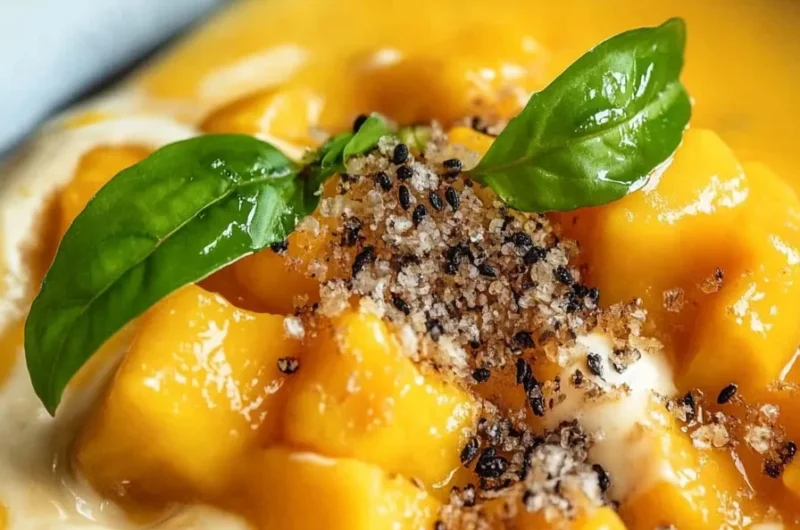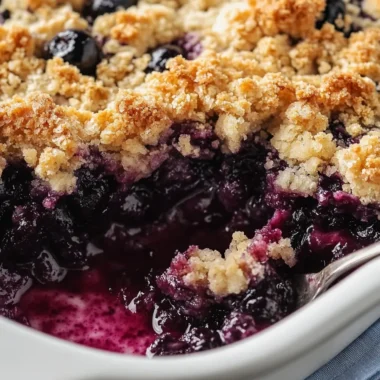Mango Sago is a delightful dessert that brings together the tropical sweetness of ripe mangoes and the creamy texture of coconut milk and sago pearls. This refreshing dessert is a wonderful way to end a meal or simply enjoy on a hot day. With its vibrant yellow color and the chewy texture of sago, it tantalizes both the eyes and the palate.
Imagine cozy summer evenings spent with family and friends, sharing stories over bowls of this incredible dessert. Each spoonful is a burst of flavor that combines the natural sweetness of fresh mangoes with the comforting creaminess of coconut milk. With its unique ingredients and easy preparation, Mango Sago is perfect for both seasoned cooks and kitchen novices alike. The joy of making this dessert is matched only by the happiness it brings to those who taste it!
In this guide, we will explore why you’ll love this recipe, guide you through preparation and cooking times, and provide you with everything you need to create this amazing dessert. From the essential ingredients to step-by-step instructions, Mango Sago is an experience waiting to happen. Get ready to elevate your dessert game and impress everyone with this ultimate treat!
Why You’ll Love This Recipe
Mango Sago is not just another dessert; it’s a tropical paradise captured in a bowl. Here are some reasons why you will adore this recipe:
1. Fresh Ingredients – This dish predominantly features fresh mangoes, making it a healthy option.
2. Easy to Prepare – The recipe requires minimal effort, perfect for those who are busy or just starting in the kitchen.
3. Versatile Option – It can be served as a light dessert, a snack, or even during celebrations.
4. Impressive Presentation – The vivid colors and textures make it visually appealing.
5. Healthy Indulgence – With fruits and a light coconut base, this dessert feels indulgent without the guilt.
6. Perfect for Any Season – Whether it’s summer or winter, Mango Sago can brighten up any meal.
With these fantastic attributes, it’s no wonder Mango Sago has become a favorite dessert across many cultures. Each bowl stands as a testament to the delightful combination of flavors and textures, inviting everyone to enjoy a taste of the tropics.
Preparation and Cooking Time
Creating the delicious Mango Sago will take approximately 1 hour, including preparation and cooking. Here’s how the time breaks down:
– Preparation Time: 30 minutes
– Cooking Time: 25-30 minutes
– Chilling Time: 30 minutes (optional but recommended for best texture)
These timings may vary based on your kitchen experience and the tools you have at your disposal.
Ingredients
– 1 cup sago pearls
– 2 ripe mangoes, diced
– 1 can (400 ml) coconut milk
– ½ cup granulated sugar (adjust to taste)
– 1 cup water
– ½ teaspoon salt
– Fresh mint leaves for garnish (optional)
Step-by-Step Instructions
Creating your Mango Sago masterpiece is straightforward if you follow these steps:
1. Rinse the Sago Pearls: Place the sago pearls in a fine-mesh sieve and rinse them under cold water for a few minutes to remove excess starch.
2. Cook the Sago: In a pot, bring 4 cups of water to a boil. Add the rinsed sago pearls and cook for about 15-20 minutes, stirring occasionally. The pearls are ready when they become translucent.
3. Drain and Rinse: Once cooked, drain the pearls and rinse them under cold water again to halt the cooking process. Set aside.
4. Prepare Coconut Milk: In a separate saucepan, heat the coconut milk over medium heat. Add granulated sugar and salt, stirring until the sugar dissolves. Do not boil.
5. Combine Ingredients: Once the coconut mixture is warm, add the cooked sago pearls, mixing well. Cook for an additional 5 minutes to allow the flavors to meld.
6. Cool Down: Remove from heat and let the mixture cool to room temperature.
7. Assemble: In serving bowls or cups, layer the mangoes at the bottom. Pour the sago and coconut mixture over the diced mangoes.
8. Chill: Refrigerate for about 30 minutes for a delightful cold treat.
9. Serve: Before serving, stir the mixture gently. Garnish with fresh mint leaves if desired.
With these detailed steps, you can easily whip up this incredible dessert while impressing your friends and family with your culinary skills!
How to Serve
Serving Mango Sago can enhance its appeal and enjoyability. Here are some suggestions on how to serve it:
1. Presentation Matters: Use elegant bowls or clear cups to showcase the colorful layers of mango and sago.
2. Chill Before Serving: Ensure the dessert is chilled properly; it tastes best when served cold.
3. Garnish: Fresh mint leaves or extra pieces of diced mango make lovely garnishes that elevate the dish’s aesthetic.
4. Pair with Drinks: Consider serving this dessert alongside sweetened tea or coconut water for a tropical ambience.
5. Share the Joy: Make it a family affair by presenting it at gatherings or parties, allowing everyone to serve themselves.
With the right serving methods, Mango Sago is sure to leave a lasting impression on everyone. So, prepare this delightful dessert, and get ready to share the happiness it brings!
Additional Tips
– Use Ripe Mangoes: For the best flavor, select perfectly ripe mangoes. They should be fragrant and slightly soft to the touch.
– Adjust Sweetness: Taste the coconut milk mixture and adjust the sweetness to your liking. Some may prefer it less sugary, while others might want more.
– Experiment with Toppings: Add toppings like toasted coconut flakes or chopped nuts for an extra crunch.
– Enjoy Fresh: While Mango Sago can be stored, it is best enjoyed fresh for the ideal texture and flavor.
– Explore Flavor Infusions: Incorporate a splash of pandan or a hint of lime for a twist on the traditional flavor.
Recipe Variation
Feel free to try these fun variations on the classic Mango Sago recipe:
1. Tropical Fruit Medley: Mix in other tropical fruits such as diced kiwi or pineapple for a colorful fruit salad.
2. Vegan Option: Replace sugar with maple syrup or agave nectar for a vegan-friendly alternative.
3. Boba Twist: Substitute sago pearls with tapioca pearls for a boba-inspired dessert.
4. Layered Delight: Create a layered dessert by alternating layers of mango puree and coconut-sago mixture for added presentation.
5. Pudding Style: Thicken the coconut milk mixture a bit more to create a pudding-like consistency for different texture.
Freezing and Storage
– Storage: Keep leftovers in an airtight container in the refrigerator. They can be safely stored for up to 2-3 days.
– Freezing: While not recommended due to the texture change in sago, if you must, freeze the mixture without mangoes. Thaw in the refrigerator before serving.
Special Equipment
You won’t need many specialized items to create this delightful dish, but here are some essentials:
– Pot: A medium-sized pot for cooking sago pearls and heating the coconut milk.
– Fine-Mesh Sieve: For rinsing the sago pearls before and after cooking.
– Mixing Spoon: Useful for stirring the mixture and ensuring ingredients are well combined.
– Serving Bowls or Cups: Clear glass bowls or cups will beautifully showcase the layers of the dessert.
Frequently Asked Questions
Can I use frozen mango instead of fresh?
Yes, you can use frozen mango, but ensure it is fully thawed and drained of excess moisture before use.
What can I do if my sago pearls are overcooked?
If they become overly soft, it’s best to adjust future cooking times. Unfortunately, overcooked sago will lose its chewy texture.
Can I make this ahead of time?
Absolutely! You can prepare the coconut-sago mixture a day in advance. Just layer with fresh mango before serving for the best results.
Is Mango Sago gluten-free?
Yes, all the ingredients in Mango Sago are naturally gluten-free, making it a safe dessert for those with gluten sensitivities.
How can I enhance the mango flavor?
To intensify the mango flavor, consider adding a bit of mango puree on top or mixing puree in with the sago before serving.
Conclusion
Mango Sago is more than just a dessert; it’s an experience that encapsulates the essence of tropical delights. With its beautiful presentation and a balanced combination of flavors and textures, it’s a dish that can brighten any occasion. Whether you’re treating yourself or impressing guests, this dessert promises satisfaction in every bite. Enjoy the vibrant sweetness and creamy goodness of Mango Sago, and let this delightful treat transport you to a tropical paradise!

Mango Sago: The Amazing Ultimate Recipe You Need to Try
- Total Time: 5 minute
Ingredients
– 1 cup sago pearls
– 2 ripe mangoes, diced
– 1 can (400 ml) coconut milk
– ½ cup granulated sugar (adjust to taste)
– 1 cup water
– ½ teaspoon salt
– Fresh mint leaves for garnish (optional)
Instructions
Creating your Mango Sago masterpiece is straightforward if you follow these steps:
1. Rinse the Sago Pearls: Place the sago pearls in a fine-mesh sieve and rinse them under cold water for a few minutes to remove excess starch.
2. Cook the Sago: In a pot, bring 4 cups of water to a boil. Add the rinsed sago pearls and cook for about 15-20 minutes, stirring occasionally. The pearls are ready when they become translucent.
3. Drain and Rinse: Once cooked, drain the pearls and rinse them under cold water again to halt the cooking process. Set aside.
4. Prepare Coconut Milk: In a separate saucepan, heat the coconut milk over medium heat. Add granulated sugar and salt, stirring until the sugar dissolves. Do not boil.
5. Combine Ingredients: Once the coconut mixture is warm, add the cooked sago pearls, mixing well. Cook for an additional 5 minutes to allow the flavors to meld.
6. Cool Down: Remove from heat and let the mixture cool to room temperature.
7. Assemble: In serving bowls or cups, layer the mangoes at the bottom. Pour the sago and coconut mixture over the diced mangoes.
8. Chill: Refrigerate for about 30 minutes for a delightful cold treat.
9. Serve: Before serving, stir the mixture gently. Garnish with fresh mint leaves if desired.
With these detailed steps, you can easily whip up this incredible dessert while impressing your friends and family with your culinary skills!
- Prep Time: 15 minutes
- Cook Time: 25-30 minutes
Nutrition
- Serving Size: 4
- Calories: 320 kcal
- Fat: 10g
- Protein: 3g






